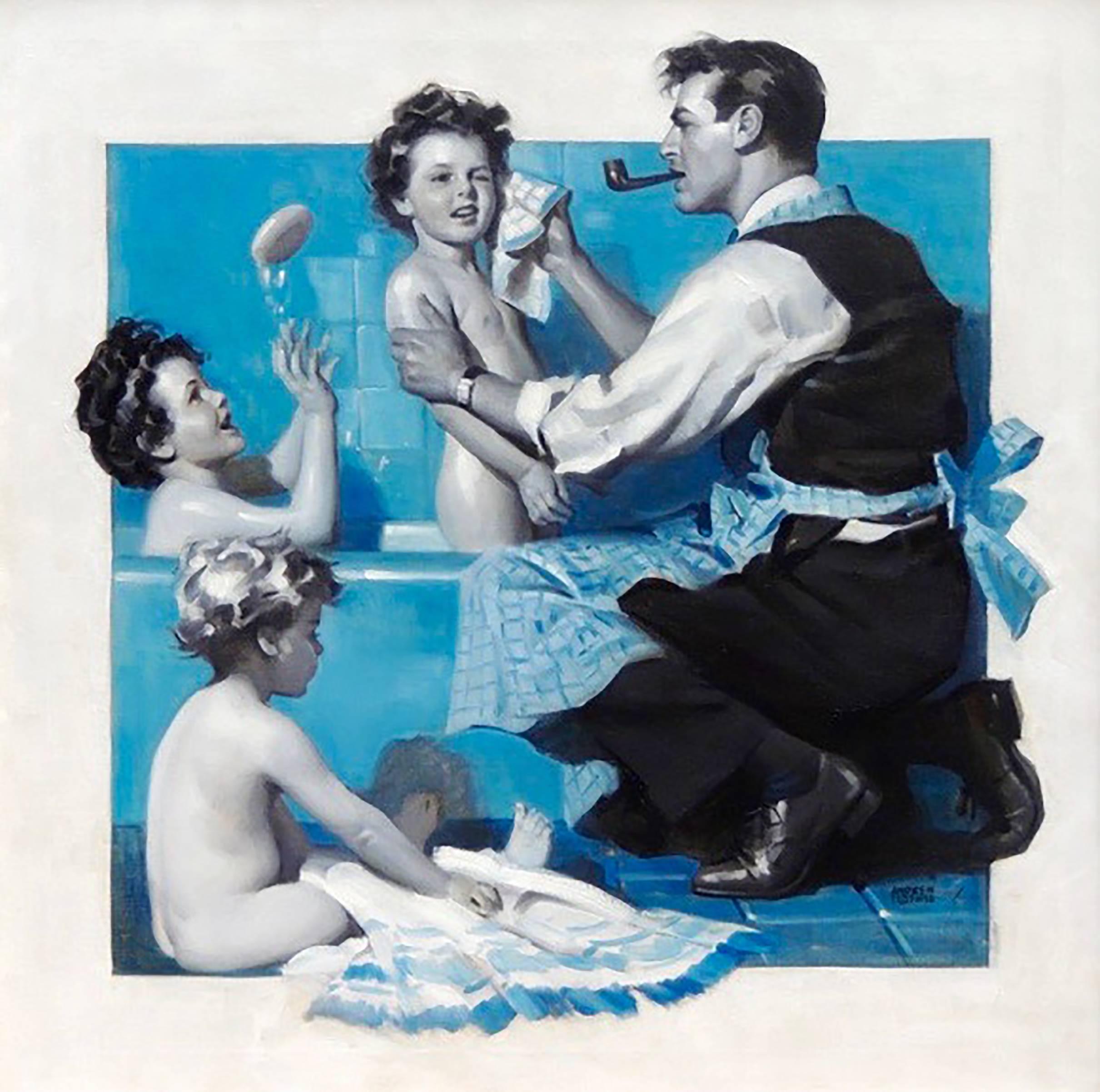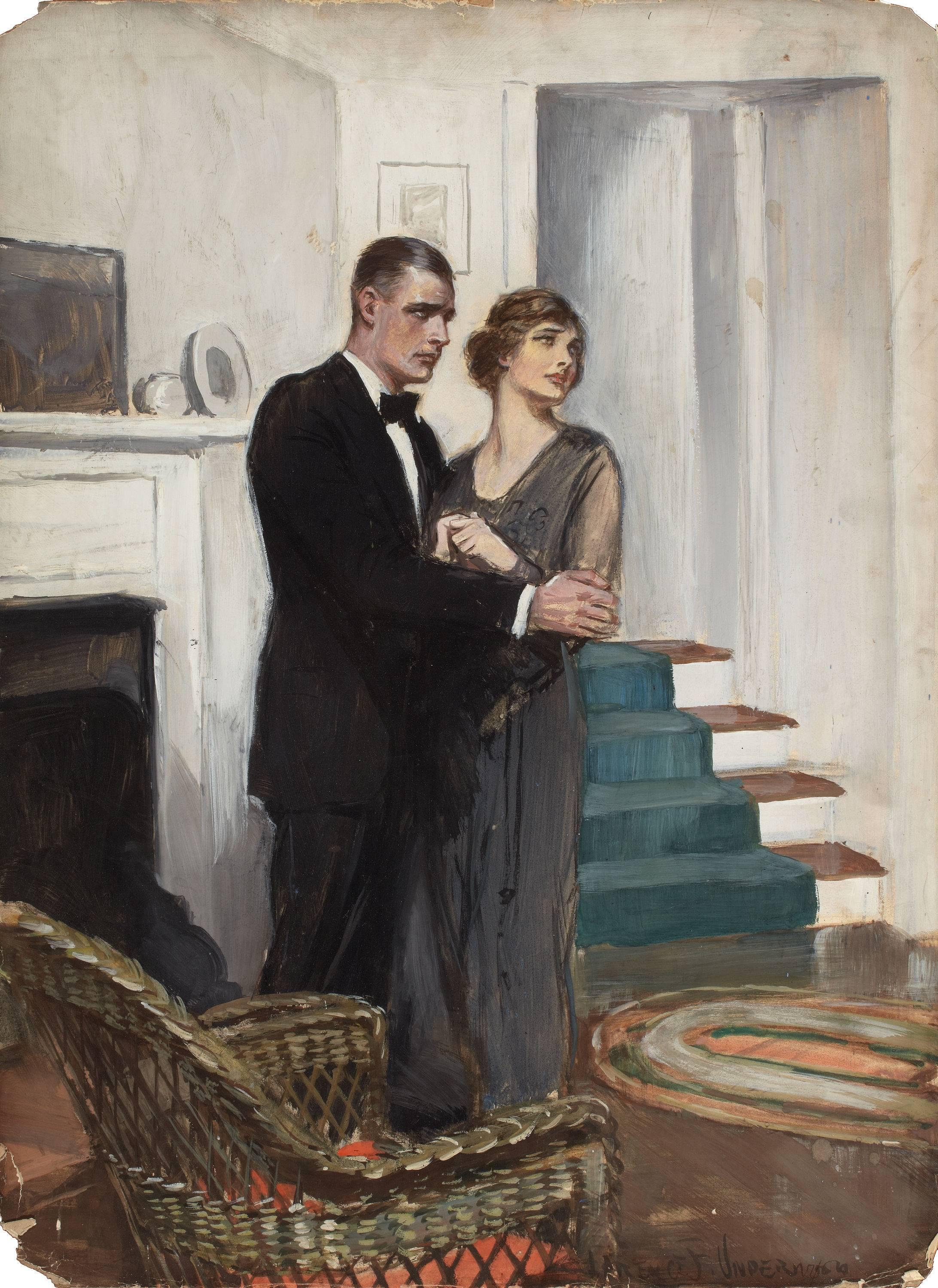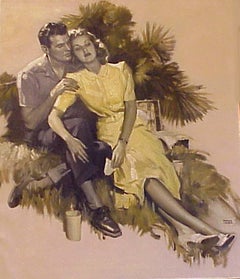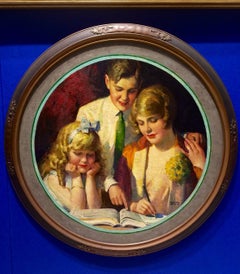Items Similar to In The Making, Pet Milk Company Advertisement
Want more images or videos?
Request additional images or videos from the seller
1 of 7
Andrew LoomisIn The Making, Pet Milk Company Advertisement
$13,000
£9,730.31
€11,243.49
CA$18,026.67
A$20,192.18
CHF 10,497.69
MX$249,332.82
NOK 133,732.31
SEK 126,423.09
DKK 83,905.04
Shipping
Retrieving quote...The 1stDibs Promise:
Authenticity Guarantee,
Money-Back Guarantee,
24-Hour Cancellation
About the Item
Pet Milk Company Advertisement
Signed lower center.
As a youngster, William Andrew Loomis loved to draw pictures, but it was a visit to the nearby studio of Howard Chandler Christy that made him decide to seek for himself an artist’s career.
Loomis was born in Syracuse, New York, and grew up in Zanesville, Ohio. At 19, he went to New York to attend the Art Students League, where he studied under George Bridgman and Frank Vincent DuMond.
In 1915, he got a job in Chicago with the art organization of the Charles Daniel Frey; he also attended classes at the Chicago Art Institute. This was interrupted in 1917 when he enlisted in the Army and served 20 months, half of them in France.
After the war, Loomis returned to Chicago to work at the Charles Everett Johnson advertising art studio, then for Bertch and Cooper. He finally opened his own studio as a free-lance artist. Equally at home in either editorial or advertising illustration, Loomis had a long career in both and also painted many twenty-four-sheet poster advertisements.
This broad experience especially qualified him as a teacher at the American Academy of Art in Chicago. Countless other art students who could not study with him personally benefited from his several art books, including Fun With a Pencil, Drawing for All It’s Worth, and Creative Illustration, published by The Viking Press. In 1999 Looms was inducted into the Society of Illustrators’ Hall of Fame.
- Creator:Andrew Loomis (1892 - 1959)
- Dimensions:Height: 30 in (76.2 cm)Width: 20 in (50.8 cm)
- Medium:
- Period:
- Condition:
- Gallery Location:Fort Washington, PA
- Reference Number:Seller: 10311stDibs: LU38431084353
About the Seller
5.0
Recognized Seller
These prestigious sellers are industry leaders and represent the highest echelon for item quality and design.
Platinum Seller
Premium sellers with a 4.7+ rating and 24-hour response times
Established in 1995
1stDibs seller since 2016
127 sales on 1stDibs
Typical response time: 3 hours
- ShippingRetrieving quote...Shipping from: Fort Washington, PA
- Return Policy
Authenticity Guarantee
In the unlikely event there’s an issue with an item’s authenticity, contact us within 1 year for a full refund. DetailsMoney-Back Guarantee
If your item is not as described, is damaged in transit, or does not arrive, contact us within 7 days for a full refund. Details24-Hour Cancellation
You have a 24-hour grace period in which to reconsider your purchase, with no questions asked.Vetted Professional Sellers
Our world-class sellers must adhere to strict standards for service and quality, maintaining the integrity of our listings.Price-Match Guarantee
If you find that a seller listed the same item for a lower price elsewhere, we’ll match it.Trusted Global Delivery
Our best-in-class carrier network provides specialized shipping options worldwide, including custom delivery.More From This Seller
View All'Another Woman' Story Illustration
By Andrew Loomis
Located in Fort Washington, PA
Medium: Oil on Canvas
Signature: Signed Lower Right
Ladies Home Journal, December 1939, pg 31. Illustration for Mary Hastings Bradley "Another Woman"
"The kiss had been less casual...
Category
1930s Figurative Paintings
Materials
Canvas, Oil
"Marriage is a Private Affair, " story illustration for The Ladies' Home Journal
By Andrew Loomis
Located in Fort Washington, PA
Story illustration for “Marriage is a Private Affair” by Judith Kelly, published in the Ladies’ Home Journal, March 1941, page 13. Featuring a young bride and groom embracing as a ma...
Category
1940s Other Art Style Paintings
Materials
Canvas, Oil
Shopping the Catalog, Sears, Roebuck Catalog Cover
By Andrew Loomis
Located in Fort Washington, PA
Medium: Oil on Board
22.00" Oval, Framed 31.00" Oval
Signature: Signed Lower Right
Sears Magazine Cover, Fall- Winter 1927/1928
Category
1920s Figurative Paintings
Materials
Oil, Board
The Heart Remembers
By Andrew Loomis
Located in Fort Washington, PA
Date: 1941
Medium: Oil on Canvas
Dimensions: 30.00" x 50.00"
Signature: Signed Lower Left
Category
1940s Figurative Paintings
Materials
Canvas, Oil
Family Man
By Andrew Loomis
Located in Fort Washington, PA
Date: 1939
Medium: Oil on Canvas
Dimensions: 32.00" x 32.00"
Signature: Signed Lower Right
This illustration was featured in the September 1939 issue of Ladies' Home Journal. P...
Category
1930s Figurative Paintings
Materials
Canvas, Oil
Saturday Evening Post Illustration
By Clarence Underwood
Located in Fort Washington, PA
Medium: Gouache on Board
Dimensions: 30.00" x 22.00"
Signature: Signed Lower Right
Category
20th Century Interior Paintings
Materials
Gouache, Board
You May Also Like
American Art Deco 20th Century Modernism Social Realism WPA Era Scene Pin-Up
Located in New York, NY
American Art Deco 20th Century Modernism Social Realism WPA Era Scene Pin-Up
Arthur Rosenman Ross (1913 - 1981)
'Edward, This Man Insulted Me. Do Something"
Sight: 20 x 15 inches
Wa...
Category
1930s American Realist Figurative Drawings and Watercolors
Materials
Watercolor, Board
"Successful Campaign" Mid Century Short Story Illustration Original
Located in Soquel, CA
A mid-century American Impressionist oil painting depicting two men with an American Flag in the background by Charles Ross Kinghan (American, 1895-1984). Like much of Kinghan's work, this painting is the original that was used for short story illustration.
Signed "Kinghan" lower left. Presented in a wood frame. Image, 24"L x 20"H. Frame, 22"H x 26"W.
Charles Ross Kinghan was born in Anthony, Kansas on January 18, 1895. A teacher, he moved to Wichita as a teenager and did sign painting for the Western Sign Works. Kinghan later studied at the Chicago Academy of Fine Art in 1916, the American Academy of Art in Chicago, the Audubon School of Art and the Art Institute of Chicago. He was a pupil of Carl Scheffler, J. Wellington Reynolds, and H.A. Oberteuffer.
He taught at the Art Institute of Chicago and at the American Academy of Art in Chicago. He was an illustrator for McCalls, Good Housekeeping, Saturday Evening Post, Colliers, and many other magazines including American Artist magazine.
He was author and illustrator of Rendering Techniques for Commercial Art and Advertising (1956) and of Ted Kautzky...
Category
Mid-20th Century American Impressionist Figurative Paintings
Materials
Canvas, Oil
Ballantine Beer Ad. Mid-Century American Illustration
Located in Miami, FL
Only Ballantine Ale Brews "Brewer's Gold," ad illustration appeared in the major magazines of the day. A magic moment is caught at a peak point of drama.
It's the instant of friends having fun.
A cold beer from the fridge is offered and it's is acknowledged with a head nod.
The woman in the foreground covers her giggling face reacting to a funny comment.
The decisive moment is preserved.
Sounds like a critique of an art photograph?
No, it's an illustrator.
This ingenious Infiniti "S" composition simultaneously represents the best of photography and painting.
Cartier-Bresson could have captured the precise moment.
While Nicolas Poussin could have rendered the complex figural composition.
Add to it , a painting technique and color scheme with the quick drama of a post-impressionist.
We have a great work of art by an overlooked American illustrator/artist/painter, Mike Ludlow...
Category
1950s Figurative Paintings
Materials
Gouache, Board
Art Deco Coulple Magazine Story Illustration, RedBook The Saturday Evening Post
By Seymour Alling Ball
Located in Miami, FL
Signed lower left: Seymour Ball Inscribed upper left: To Morris E Weiss with best wishes Seymour Ball" Matted not framed
Category
1930s Art Deco Figurative Drawings and Watercolors
Materials
India Ink, Watercolor, Illustration Board
"Happy Family", Mid Century Sepia Figurative Interior Scene, Illustration Art
Located in Soquel, CA
"Happy Family", Mid Century Sepia Figurative Interior Scene, Illustration Art by Charles Kinghan
A classic and heartwarming mid-century sepia toned figurative interior scene by Charles Ross Kinghan (American, 1895-1984). Circa 1940's. This mid-century piece exemplifies the classic style of illustrations and advertisements from the period, and depicts a family gathered in their living room.
Signed "Kinghan" in the lower right corner. Acquired with other works by the artist.
Displayed in a period giltwood frame.
Linen size: 36"H x 30"W.
Framed size: 45"H x 38.5"W x 2"D.
Charles Ross Kinghan (American, 1895-1984) was born in Anthony, KS on January 18, 1895. A teacher, he moved to Wichita as a teenager and did sign painting for the Western Sign...
Category
Mid-20th Century American Impressionist Figurative Paintings
Materials
Linen, Oil
Mary Vincent and the Convict, Good Housekeeping Illustration - Mid Century
By Al Parker
Located in Miami, FL
Al Parker was one of America's greatest and most inventive illustrators. He did work for magazines such as: Chatelaine, Collier's, Ladies' Home Journal and Woman's Home Companion. ...
Category
1950s American Realist Figurative Paintings
Materials
Masonite, Gouache, Pencil
More Ways To Browse
Worth And Company
Vintage Advertisement Art
Framed Vintage Advertisements
Viking Art
Charles Howard Artist
William Vincent
Howard Johnsons
Viking Painting
Howard Johnson Vintage
Vintage Chandlers
Milk Poster
Vintage Posters Milk
William Chandler
Pink Sky Paintings
Comic Pop Art
Frank Oil Paint
Monumental Oil Painting
French Romantic Painting










